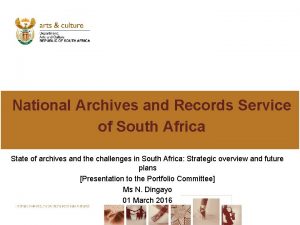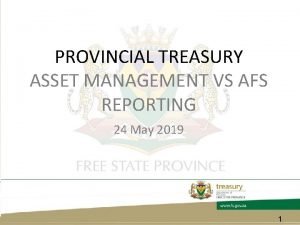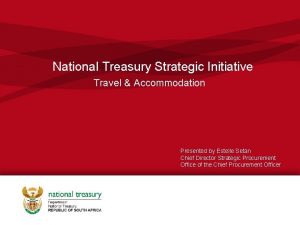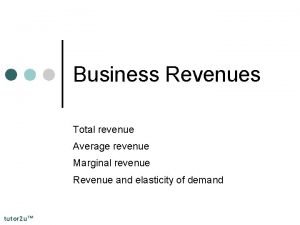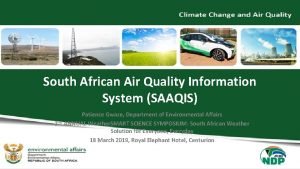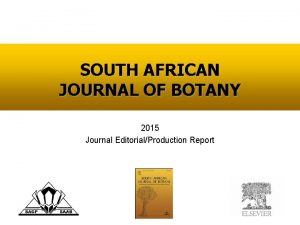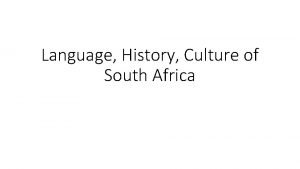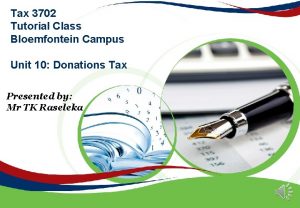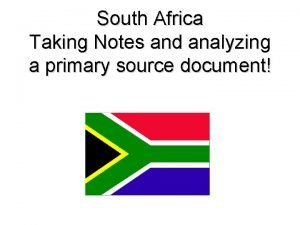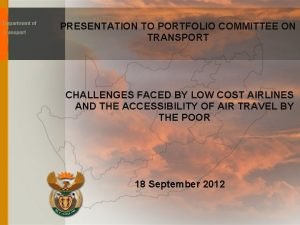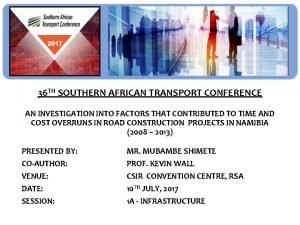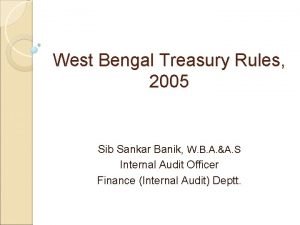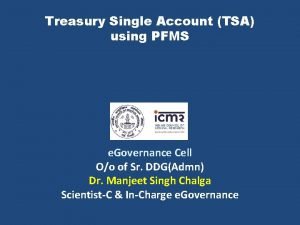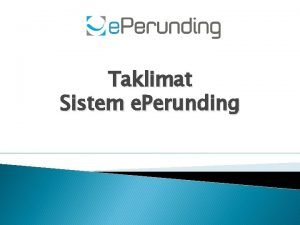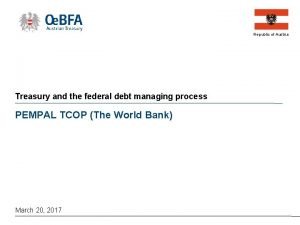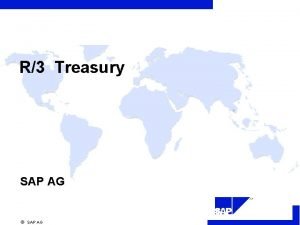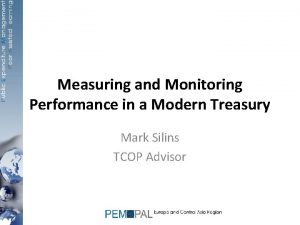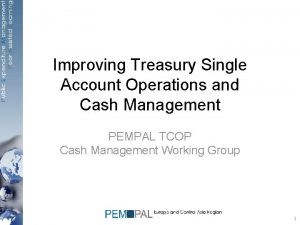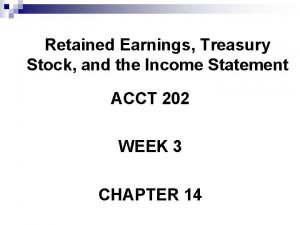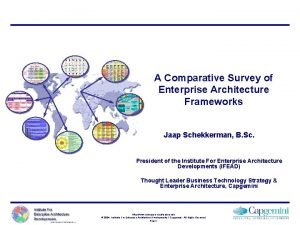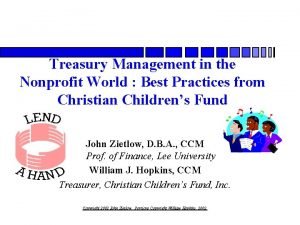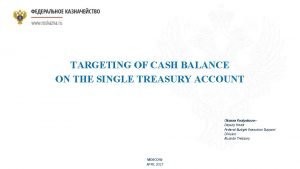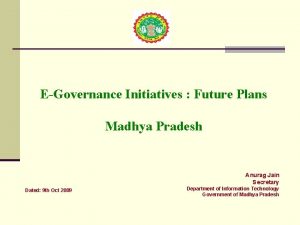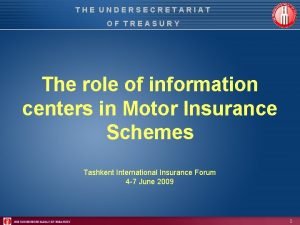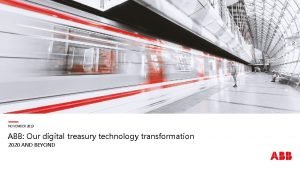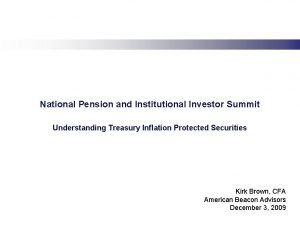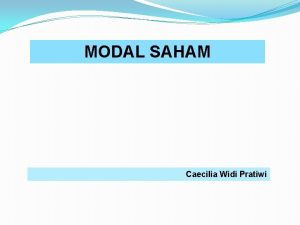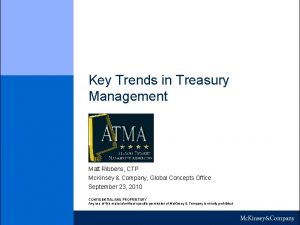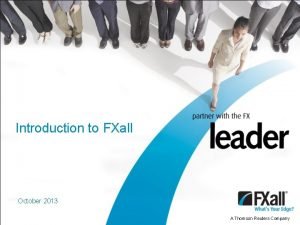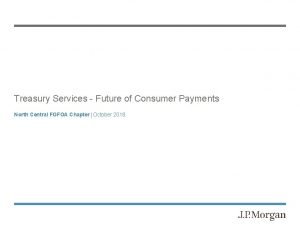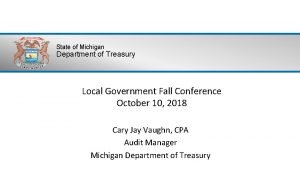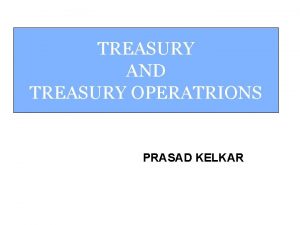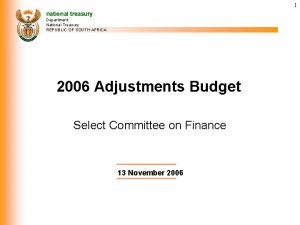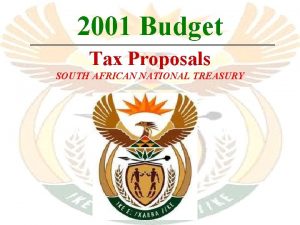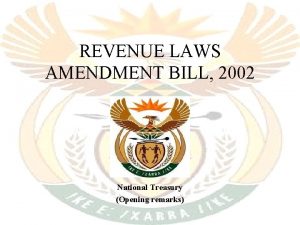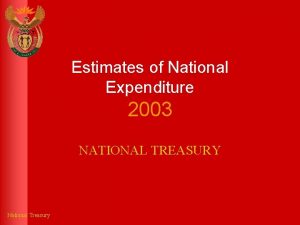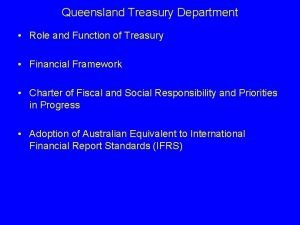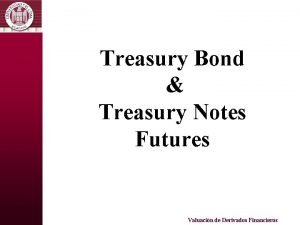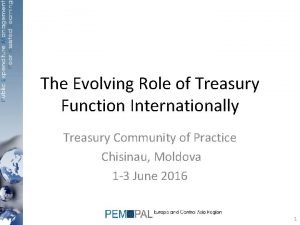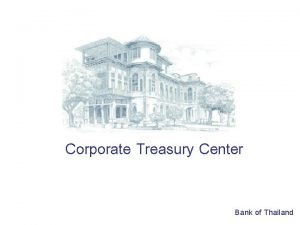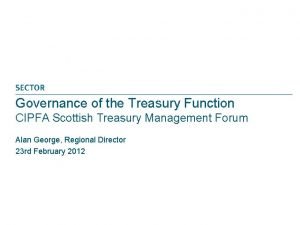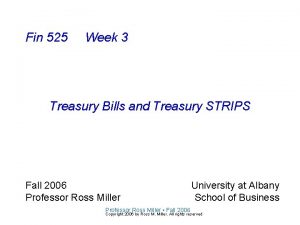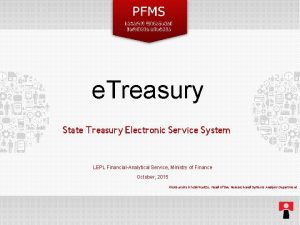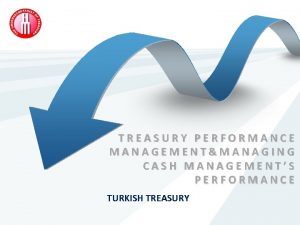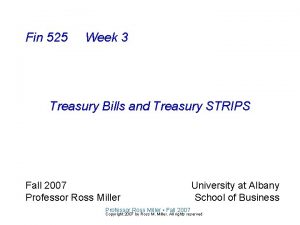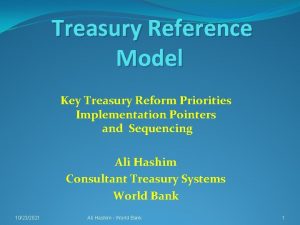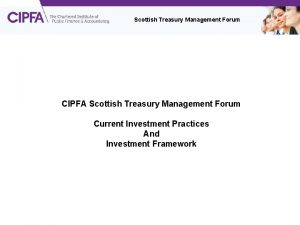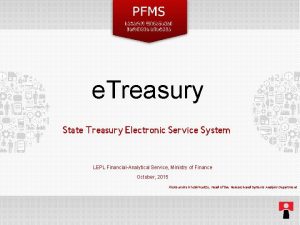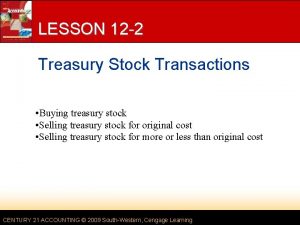National Treasury South African Revenue Services Statistics South










































- Slides: 42

National Treasury South African Revenue Services Statistics South Africa Budget Analysis

National Treasury Budget Analysis

Mandate of the Treasury • Support economic growth and development, • Promote good governance and social progress • Foster accountable, economical, efficient, equitable and sustainable management of public finances. • Fiscal principles - counter-cyclicality, intergenerational fairness and debt sustainability

Broader Economic and Fiscal. Policy • Manage revenue and expenditure - economic recovery, fiscal sustainability and fiscal consolidation • Limit the cost of service delivery - eliminate ineffective or wasteful expenditure • Improve Value For Money - target spending on policies and programmes with the greatest developmental impact

Policy Priorities • Maintaining an explicit expenditure ceiling • Real increases in spending within set expenditure ceiling: 2014/15 (R 1. 03 trillion); 2015/16 (R 1. 11 trillion); 2016/17 (R 1. 18 trillion) • Capital spending and capital transfers are the fastestgrowing components of non-interest expenditure. • Challenge: strike a balance between cost containment and service delivery – consider infrastructure investment, social grants and service delivery needs

Policy Priorities

Strategic objectives • Prepare, finance, publish and monitor the execution of the annual national budget • Improve techniques to monitor and analyse public expenditure • Ensure the appropriate use of available public financial resources for socio-economic development and infrastructure investment; • Contribute to improved capacity in financial management and resource planning in government;

Strategic Objectives (Cont. ) • Contribute to the development of a stable and robust financial sector; • Support infrastructure and urban development; • Promote public private partnerships as a financing alternative for development, where feasible; and • Enhance SCM in government through the establishment of the Chief Procurement Office,

Current spending • Aim: tight control of goods and services budget effect cuts on travel, catering, consultants, conferences, entertainment, etc. • Current budget – 23% of the budget. • 99% - interest on land • Goods and services – consultants and business services (30%) and computer services (33%)

Current Expenditure

Transfers - 77% of budget

Capital Expenditure • Mostly on software and other intangible assets – 94% of capital budget • Budget grows by 4. 75% in nominal terms, but declines by 1. 36% in real terms • Machinery and equipment budget declines sharply by 59. 2% in nominal terms (62. 07% in real terms)

Programmes Administration; Economic Policy, Tax, Financial Regulation and Research; Public Finance and Budget Management; Asset and Liability Management; Financial Systems and Accounting; International Financial Relations; Civil and Military Pensions, Contributions to Funds and Other Benefits; • Technical Support and Development Finance; • Revenue Administration; and • Financial Intelligence and State Security. • •

Budget growth trends – 2014/15 • Budget grew by 2. 12% in real terms, • Monetary increase of R 2 billion, mostly (41. 39%) for the Technical Support and Development Finance Programme. • Increase will also fund the Neighbourhood Development Partnership Grant and Integrated Cities Development Grant. • SARS (Prog 9) gets the bulk of the budget – 35%.

Administration 2% of Vote • Provides strategic leadership, management and administrative support to the department • Budget has been reduced in real terms by 8. 92 per cent in comparison to the previous year • 98% spent on current payments, 51% of which is spent on Compensation of employees • Most of the goods and services budget (28%) will be spent on operating leases • Concern: Programme has been under-spending for the last few years

Economic Policy, Tax, Financial Regulation and Research 1% of Vote • Provides specialist policy research, analysis & advisory services - economic policy, tax, financial sector and regulatory reform • Allocation decreases in real terms • 76% of current budget is allocated to for compensation of employees and 24 % to goods and services • 50% of goods and services budget to consultants and professional services • Most expenditure - Financial Sector policy, Tax policy and Economic policy sub programmes. • Concern: Significant under-expenditure due to unfilled vacancies in legal design tax unit

Public Finance and Budget Management 1% of Vote • Provides advice and analysis on fiscal policy and public finances, IGFR, expenditure planning, etc • Increased by 7. 5% in real terms, mostly (86%) allocated to Compensation of Employees • Expenditure priorities - improving provision of financial management, budgeting and expenditure management support. • Concern: 47 vacancies due to a lack of capacity in the (relatively new) public service pensions and benefits unit.

Asset and Liability Management 13% of Vote • Ensure prudent cash management and an optimal portfolio of debt and other fiscal obligations • Financial investments subprogramme – 98% of programme budget – for Capital payments for recapitalisation of DBSA, the Land Agricultural Development Bank of SA, Postbank - up to end of 2015/16.

Financial Accounting and SCM 3% of Vote • Promote and enforce transparent, economic and effective management of revenue, expenditure, assets, liabilities and SCM processes in the public sector • 66% spent on current expenditure, mostly on computer services (47% of current budget) • Financial systems subprogramme – 58% to develop, implement and maintain new integrated financial management system

International Financial Relations 5% of Vote • Mostly transfers to African Integration and support (54%) and International Development Funding Institutions (42%) • Transfer payments to the common monetary area compensation increase by R 8. 99 million or 1. 5 % to R 622. 84 million. • Transfers to the ADB and ADF increase by R 36. 59 million (91 %increase) in 2014/15 to recapitalise the entities and buy shares, and replenishment of the ADF

Civil and Military Pensions, Contributions to Funds and Other Benefits 14 % of Vote • Provides for pension and post-retirement medical benefit organisations to former State employees and retired members of the military • 98. 4 % of the budget is transferred to households, 46. 2 %of these go towards postretirement medical scheme contributions

Technical Support and Development Finance 14% of Vote • Provide specialised infrastructure development planning, implementation support and technical assistance, to aid capacity building in the public sector • 38% transfers to provinces and municipalities • 53% transfers to public enterprises and public corporations • Most expenditure takes place through the Employment Creation Facilitation sub-programme - implementation of the jobs fund • 41% growth in real terms • Comment: Department should report on jobs created to the committee – impact at service delivery level

Revenue Administration 35% of Vote • Entire allocation is transferred to SARS to provide core tax administration services and maintain IT services that support its operations • 2014/15 allocation declines by 6. 33 % in real terms due to a tightening of the budget (Cabinet approved baseline reduction of R 1. 4 billion on the transfer over the medium term). • Reduction won’t have a negative impact on performance of SARS - SARS has accumulated adequate accumulated surplus to cover its operations

Financial Intelligence and State Security 16% of Vote • To combat financial crime for national security, etc through the Financial Intelligence Centre Act • R 4. 17 billion or 96. 1%of this budget will be transferred to the South African Secret Services Account • Comment: The department should provide a progress report on the service delivery implementation and performance of the institution, as well as provide a report on the monitoring mechanisms that are applied in this regard.

Committee considerations • Provide a progress report on the service delivery implementation and performance, including monitoring mechanisms of the institution and its entities. • Provide a report on how the department will fill vacant positions. • Committee should monitor the infrastructure investment framework – both capital spending and capital transfers

SARS BUDGET ANALYSIS Standing Committee on Finance

SARS mandate • To ensure optimal compliance with tax and customs legislation. • Ensure compliance is achieved in a manner that does not unduly impede trade, economic growth and development. • Ensure compliance is achieved in the most efficient and cost effective manner. • Achieved 84% (2013/14) and 83% (2012/13) in compliance – PAYE Tax filing

Achievements of the 2013/14 financial year

Policy priorities for 2014/15 • Aim - to support the National Development Plan’s economic and social objectives. • Ensure a sustainable revenue stream for government to meet its policy and delivery priorities. • Four core outcomes serve as the foundation of all current and future activities: • Increase customs compliance; • Increase tax compliance; • Increase the ease and fairness of doing business with SARS; and • Increase the cost effectiveness, internal efficiency and institutional respectability of its operations.

Risks faced by SARS • Growing illicit economic activities • Perceptions of poor state service delivery and corruption - negatively affects taxpayer’s attitude towards compliance; • Tax evasion practices: businesses increasingly try to evade tax obligations and minimise the impact of slow economic recovery on their profitability; and • Vat fraud could increase as businesses try to protect their profitability.

Responses to risks • Deploying officials to reach all current and potential taxpayers, • Outreach, educational and other compliance activities; • Developing and procuring mobile registration kits to facilitate the registration of new taxpayers; • Increasing border control activities; and • Pursuing information exchange agreements • Introducing regulatory and legislative reforms to counter tax avoidance schemes.

Budget Analysis • For 2014/15 - SARS receives an allocation of R 9. 7 billion, up by R 671. 9 million or 7. 5 per cent in nominal terms (or 1. 2 per cent in real terms) from the previous year’s allocation of R 9. 0 billion. • Over the medium-term, the budget is expected to increase at a nominal average rate of 6. 1 per cent, reaching R 10. 8 billion by 2016/17. • SARS’s budget is divided among five programmes - the bulk is allocated to the Operation programme (R 5. 6 billion or 57. 8 %), and the Administration programme (R. 1 billion or 32. 3 per cent).

Budget Analysis(Cont. ) • Nearly two-thirds of the Operations and Administration programmes’ spending is on compensation of employees. • Specifically on audit, IT and tax administration specialists’ skills, which are critical for SARS to deliver on its mandate. • In instances where SARS lacks capacity, consultants are used for legal, auditing and IT related services of which spending on consultants amounted to R 238. 2 million in 2013/14. • As SARS intends building internal capacity in these areas, spending on consultants is expected to decrease to R 205. 9 million by 2016/17.

Key issues for consideration by Parliament • SARS should report on progress made with respect to filling the critical skills required by the organisation - vacant posts with regard to audit, IT and tax administration specialists? • The 2013/14 -2017/18 Strategic Plan highlights the need for a succession plan as 20% of senior leadership may potentially be leaving in the next 4 years due to retirement or expiration of contracts. Has SARS identified potential successors and/or planned for an appropriate handover and grooming process? • SARS should regularly update the committee on it’s risk-mitigation strategies pertaining to all identified risks as well as other challenges – highlight any pertinent gaps or challenges

Statistics South Africa Budget Analysis Standing Committee on Finance

Stats SA mandate • Statistics Act (1999) – advance production, dissemination, use and coordination of official and other statistics to assist organs of state, businesses, other organisations and the public in planning, monitoring, and decision making. • Coordinate statistical production among organs of state in line with the purpose of official statistics and statistical principles.

Policy priorities for 2014/15 • Key priorities over the medium-term include: – Expand the statistical information base by increasing its depth, breadth and geographical spread - production of economic, social and population statistics; – Develop and enhance qualitative and methodological standards; – Integrate fieldwork and data operations, provide management support, and implement effective governance and administration; – Lead the development and coordination of statistical production in the national statistics system.

Budget Analysis • Receives R 2. 2 billion, up by R 500. 9 million - 28. 8 % nominal increase(or 21. 2 % real increase) from the 2013/14 allocation of R 1. 7 billion. • Stats SA’ budget is divided among seven programmes • Administration programme receives the largest share (R 934. 7 million or 41. 7%) • Statistical Collection and Outreach programme receives R 524. 5 million or 23. 4 per cent. • Collectively, the two programmes receive 65% of the budget

Budget Analysis(Cont. ) • 55% (R 1. 2 billion) of the budget is allocated to compensation of employees due the labour intensive nature of survey activities. • Goods and services amount to R 536. 1 million, down by R 52. 6 million from the R 588. 7 million allocated in the previous financial year. • The largest expenditure components of the goods and services budget include: operating leases (26%); computer services (17%); and travel and subsistence (16%).

Budget Analysis(Cont. ) • Transfers and subsidies declined by R 2. 6 million (14. 7%) in nominal terms from R 17. 7 million in 2013/14 to R 15. 1 million in 2014/15. • Capital payments increased by R 427. 7 million from R 32. 0 million in 2013/14 to R 459. 7 million in 2014/15. • The bulk (i. e. R 421. 2 million) of this increased capital allocation is to be spent by the Office Accommodation subprogramme (Administration) on buildings and other fixed structures.

Key issues for consideration by Parliament • The Department previously reported to the Committee that it did not meet some of its performance targets due to capacity constraints. • Provide the Committee with details regarding staff establishment, skills retention and other strategies to ensure that it meets its targets • The Department previously reported that they had challenges in recruiting finance and statistical skills, is this still the case? • What is the department’s plan to ensure that these critical posts are filled?

THANK YOU
 Naairs south africa
Naairs south africa Asset management framework national treasury
Asset management framework national treasury Estelle setan national treasury
Estelle setan national treasury Average
Average Hamilton south africa
Hamilton south africa South african air quality information system
South african air quality information system Louay safi
Louay safi South african journal of botany impact factor 2020
South african journal of botany impact factor 2020 Apartheid
Apartheid South african bont tick
South african bont tick South african tax
South african tax Sacap architectural compliance certificate
Sacap architectural compliance certificate South african freedom charter pdf
South african freedom charter pdf South african tax
South african tax South african plateau map
South african plateau map South african council for natural scientific professions
South african council for natural scientific professions South african principals association
South african principals association South african transport conference
South african transport conference Seamless southern africa
Seamless southern africa Introduction to statistics what is statistics
Introduction to statistics what is statistics Colt investor relations
Colt investor relations Wb treasury rules 2005
Wb treasury rules 2005 Treasury
Treasury Treasury single account pfms
Treasury single account pfms Eperunding treasury
Eperunding treasury Treasury report example
Treasury report example Sap treasury workstation
Sap treasury workstation Treasury kpi metrics
Treasury kpi metrics Features of treasury single account
Features of treasury single account Sk global treasury automation
Sk global treasury automation Retained earnings treasury stock
Retained earnings treasury stock Extended enterprise architecture framework
Extended enterprise architecture framework Treasury best practices
Treasury best practices Treasury cash balance
Treasury cash balance Cyber treasury mponline
Cyber treasury mponline Undersecretariat of treasury (turkey)
Undersecretariat of treasury (turkey) Abb treasury
Abb treasury Treasury inflation protected securities cfa
Treasury inflation protected securities cfa Materi modal saham
Materi modal saham Trends in treasury management
Trends in treasury management Fxall treasury center
Fxall treasury center Treasury
Treasury State of michigan chart of accounts
State of michigan chart of accounts
